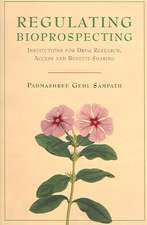Management and the Conservation of Biodiversity: Topics in Biodiversity and Conservation, cartea 10
Editat de David Leslie Hawksworthen Limba Engleză Paperback – 4 mai 2012
The organisms and communities considered embrace birds, coral reefs, various large and small mammals, reptiles, forest trees, and dune and boreal semi-natural grassland plants. The contributions are taken from situations being confronted in regions including the Andaman Islands, Brazil, Canary Islands, the Caribbean, Finland, Germany, Guinea, India, Italy, Mexico, Myanmar, Poland, South Africa, Spain, and the USA.
Collectively, the studies presented here provide a snap-shot of the types of management actions being undertaken for conservation and their efficacy. This makes the volume especially valuable for use in conservation biology courses.
Reprinted from Biodiversity and Conservation, volume 18, No 4 (2009)
| Toate formatele și edițiile | Preț | Express |
|---|---|---|
| Paperback (1) | 947.50 lei 6-8 săpt. | |
| SPRINGER NETHERLANDS – 4 mai 2012 | 947.50 lei 6-8 săpt. | |
| Hardback (1) | 952.09 lei 6-8 săpt. | |
| SPRINGER NETHERLANDS – 11 dec 2009 | 952.09 lei 6-8 săpt. |
Din seria Topics in Biodiversity and Conservation
- 24%
 Preț: 1605.63 lei
Preț: 1605.63 lei - 18%
 Preț: 1239.49 lei
Preț: 1239.49 lei - 18%
 Preț: 1218.21 lei
Preț: 1218.21 lei - 18%
 Preț: 942.31 lei
Preț: 942.31 lei - 18%
 Preț: 944.51 lei
Preț: 944.51 lei -
 Preț: 435.38 lei
Preț: 435.38 lei - 15%
 Preț: 646.62 lei
Preț: 646.62 lei - 24%
 Preț: 806.76 lei
Preț: 806.76 lei - 18%
 Preț: 1114.65 lei
Preț: 1114.65 lei - 18%
 Preț: 1126.35 lei
Preț: 1126.35 lei - 18%
 Preț: 1834.27 lei
Preț: 1834.27 lei - 18%
 Preț: 1019.49 lei
Preț: 1019.49 lei - 18%
 Preț: 1236.38 lei
Preț: 1236.38 lei - 18%
 Preț: 1231.47 lei
Preț: 1231.47 lei - 18%
 Preț: 1236.38 lei
Preț: 1236.38 lei - 18%
 Preț: 1230.66 lei
Preț: 1230.66 lei - 18%
 Preț: 1232.71 lei
Preț: 1232.71 lei - 18%
 Preț: 1376.53 lei
Preț: 1376.53 lei - 18%
 Preț: 944.51 lei
Preț: 944.51 lei
Preț: 947.50 lei
Preț vechi: 1155.48 lei
-18% Nou
Puncte Express: 1421
Preț estimativ în valută:
181.32€ • 196.89$ • 152.31£
181.32€ • 196.89$ • 152.31£
Carte tipărită la comandă
Livrare economică 22 aprilie-06 mai
Preluare comenzi: 021 569.72.76
Specificații
ISBN-13: 9789400731059
ISBN-10: 9400731051
Pagini: 360
Ilustrații: VIII, 352 p.
Dimensiuni: 155 x 235 x 19 mm
Greutate: 0.5 kg
Ediția:2010
Editura: SPRINGER NETHERLANDS
Colecția Springer
Seria Topics in Biodiversity and Conservation
Locul publicării:Dordrecht, Netherlands
ISBN-10: 9400731051
Pagini: 360
Ilustrații: VIII, 352 p.
Dimensiuni: 155 x 235 x 19 mm
Greutate: 0.5 kg
Ediția:2010
Editura: SPRINGER NETHERLANDS
Colecția Springer
Seria Topics in Biodiversity and Conservation
Locul publicării:Dordrecht, Netherlands
Public țintă
ResearchTextul de pe ultima copertă
This book brings together a selection of 21 original studies submitted to Biodiversity and Conservation that address aspects of management for the conservation of biodiversity. The topics addressed include: lessons from the Northern spotted owl saga, hidden costs of implementing the EU Habitats Directive, the importance of recently created agricultural wetlands, cutting reeds to create a sustainable habitat, impacts and control of feral cats, selecting areas to complement existing reserve systems, beneficial effects of rabbit warrens, effects of fences on large predator ranges, spatial structure of critical habitats and connectivity, effects of an agro-pasture landscape on biodiversity, community involvement, reserve selection in forests, germ-plasm interventions in agroforestry systems, shade coffee plantations and the protection of tree diversity, reserves and the reduction of deforestation rates in dry tropical forests, reconciling forest conservation actions with usage by and needs of local peoples, weed invasion in understory plant communities in tropical lowland forests, problems of patch area and connectivity in plant conservation, the need not to focus just on hot-spots, and partitioning conservation across elevations.
The organisms and communities considered embrace birds, coral reefs, various large and small mammals, reptiles, forest trees, and dune and boreal semi-natural grassland plants. The contributions are taken from situations being confronted in regions including the Andaman Islands, Brazil, Canary Islands, the Caribbean, Finland, Germany, Guinea, India, Italy, Mexico, Myanmar, Poland, South Africa, Spain, and the USA.
Collectively, the studies presented here provide a snap-shot of the types of management actions being undertaken for conservation and their efficacy. This makes the volume especially valuable for use in conservation biology courses.
Reprinted from Biodiversity and Conservation, volume 18: 4 (2009)
The organisms and communities considered embrace birds, coral reefs, various large and small mammals, reptiles, forest trees, and dune and boreal semi-natural grassland plants. The contributions are taken from situations being confronted in regions including the Andaman Islands, Brazil, Canary Islands, the Caribbean, Finland, Germany, Guinea, India, Italy, Mexico, Myanmar, Poland, South Africa, Spain, and the USA.
Collectively, the studies presented here provide a snap-shot of the types of management actions being undertaken for conservation and their efficacy. This makes the volume especially valuable for use in conservation biology courses.
Reprinted from Biodiversity and Conservation, volume 18: 4 (2009)
Caracteristici
Topical case studies Broad range of organisms considered Examples from a wide range of countries Makes primary research papers on the topic available to students and practitioners





